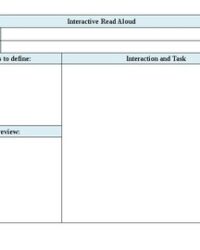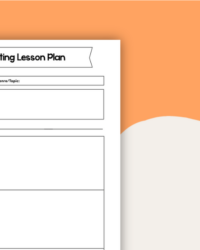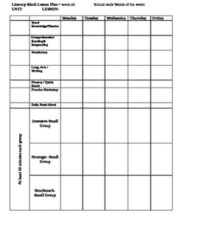Stepping into the world of shared reading is like opening a doorway to literacy and imagination for young learners. It’s a vibrant, interactive approach where an experienced reader, usually a teacher, guides a group of students through a text, modelling fluent reading, comprehension strategies, and an appreciation for stories. This powerful pedagogical tool fosters a sense of community, builds confidence, and ensures that every child, regardless of their current reading level, feels included and successful. But like any effective lesson, shared reading thrives on thoughtful preparation.
That’s where a meticulously designed shared reading lesson plan template comes into play. It transforms a potentially overwhelming task into a streamlined, enjoyable process, ensuring you cover all your bases from setting clear learning objectives to crafting engaging post-reading activities. Having a structured framework allows educators to focus more on the dynamic interactions with students and less on remembering every little detail, making each shared reading session impactful and memorable.
The Blueprint for Literacy: Why a Template Matters
Imagine walking into a shared reading session feeling completely prepared, knowing exactly what to say, what questions to ask, and how to encourage your students to participate. This isn’t just a dream; it’s the reality a comprehensive shared reading lesson plan template offers. It acts as your strategic blueprint, ensuring consistency across your lessons and helping you align each session with specific learning goals, whether you’re focusing on phonics, comprehension, vocabulary, or even social-emotional learning through literature. Without a clear plan, even the most enthusiastic teacher might miss valuable teaching moments or struggle to maintain student engagement.
A good template goes beyond just a checklist; it prompts you to think deeply about the chosen text and your students’ needs. It encourages you to anticipate areas where students might struggle, plan for differentiated instruction, and consider how the text can spark deeper conversations. This proactive planning means you’re not just reading a story; you’re orchestrating a rich learning experience where every word and illustration becomes a teaching opportunity. From the initial introduction of the book to the final reflection, each stage is carefully considered, maximizing the educational impact.
Setting the Stage: Pre-Reading Essentials
Before you even open the book, the pre-reading phase sets the foundation for comprehension and engagement. A robust shared reading lesson plan template will guide you through crucial steps like introducing the book, activating prior knowledge, making predictions, and pre-teaching challenging vocabulary. This is where you build anticipation and create connections, helping students access the text more easily. Think about how you’ll engage them with the cover, discuss the author or illustrator, or connect the story’s themes to their own lives. These initial interactions are vital for piquing curiosity and preparing their minds for the story to unfold, making the text less intimidating and more inviting.
Engaging During the Read Aloud
The “during reading” section of your template focuses on active engagement and modeling. This is where you bring the text to life, demonstrating fluent reading with expression and pacing. Your template should prompt you to identify specific points for pausing to model thinking aloud, ask inferential questions, clarify meaning, or discuss literary devices. It’s not just about reading the words; it’s about showing students *how* readers make sense of text. Encouraging choral reading, echo reading, or having students join in on repetitive phrases can significantly boost their confidence and participation. This interactive dynamic ensures that students are not passive listeners but active participants in the decoding and comprehension process.
Consolidating Learning: Post-Reading Activities
The learning doesn’t stop when the last page is turned. The post-reading phase is crucial for cementing understanding and extending learning. Your template should include prompts for discussing the story’s main ideas, characters, plot, and themes. This is also an ideal time for follow-up activities that reinforce skills or deepen comprehension. These might include drawing, writing responses, dramatizing scenes, creating alternative endings, or engaging in text-to-self, text-to-text, and text-to-world connections. These activities allow students to process the story on a deeper level and apply what they’ve learned, transforming a simple read-aloud into a comprehensive literacy lesson. This structured approach helps in building a complete learning cycle for your students.
Personalizing Your Shared Reading Journey
While a foundational shared reading lesson plan template provides an excellent starting point, its true power lies in its adaptability. No two classrooms are alike, and no two texts are identical in their teaching potential. Thinking about your specific students – their age, their background knowledge, their current reading levels, and their interests – allows you to tailor a template to truly resonate with them. Consider how you might adjust vocabulary pre-teaching for different age groups, or how you might introduce a more complex concept to older learners versus simpler story elements for younger ones. Customization ensures that the lesson is not just delivered but truly received and internalized by your unique learners, fostering deeper connections with the material and a greater love for reading.
The beauty of a well-designed template is that it evolves with your experience. As you use it repeatedly, you’ll discover what works best for your students and identify areas where you might want to add more detail or streamline certain sections. Perhaps you’ll realize the importance of adding a specific space for “student responses” or a dedicated section for “differentiated support ideas.” This ongoing refinement transforms a generic framework into a highly personalized, effective tool that reflects your teaching philosophy and your students’ learning styles. It becomes a living document that grows alongside your professional development, making each shared reading session more impactful than the last.
Consistency in using a template also builds routine and predictability for students, which can be incredibly comforting and conducive to learning. When they know what to expect from a shared reading session – the pre-reading chat, the interactive reading, the thoughtful discussion, and the engaging follow-up – they can participate more confidently and derive greater benefit. This structured approach not only maximizes learning opportunities but also fosters a positive classroom culture around reading, encouraging every student to see themselves as a capable and engaged reader. It’s about empowering both the teacher with clarity and the students with a clear path to literacy success.
- Choose a text that aligns with curriculum goals and student interest.
- Identify explicit teaching points based on the text (e.g., phonics patterns, comprehension strategies).
- Plan open-ended questions that encourage critical thinking and discussion.
- Select interactive strategies that promote active participation during the read.
- Design a meaningful extension activity that reinforces the learning objectives.
Embracing the structure of a shared reading lesson plan doesn’t just make your teaching life easier; it fundamentally enhances the learning experience for your students. By thoughtfully preparing each session, you’re not just reading a book; you’re creating an immersive, multi-faceted journey into literacy. These planned interactions, from the initial vocabulary introduction to the reflective post-reading activities, build a robust foundation for their reading development.
Ultimately, a well-executed shared reading session, meticulously planned with the aid of a template, becomes a cornerstone of your literacy program. It empowers students with strategies, confidence, and a lasting love for stories, paving the way for them to become independent, thoughtful readers who engage deeply with the world around them.


